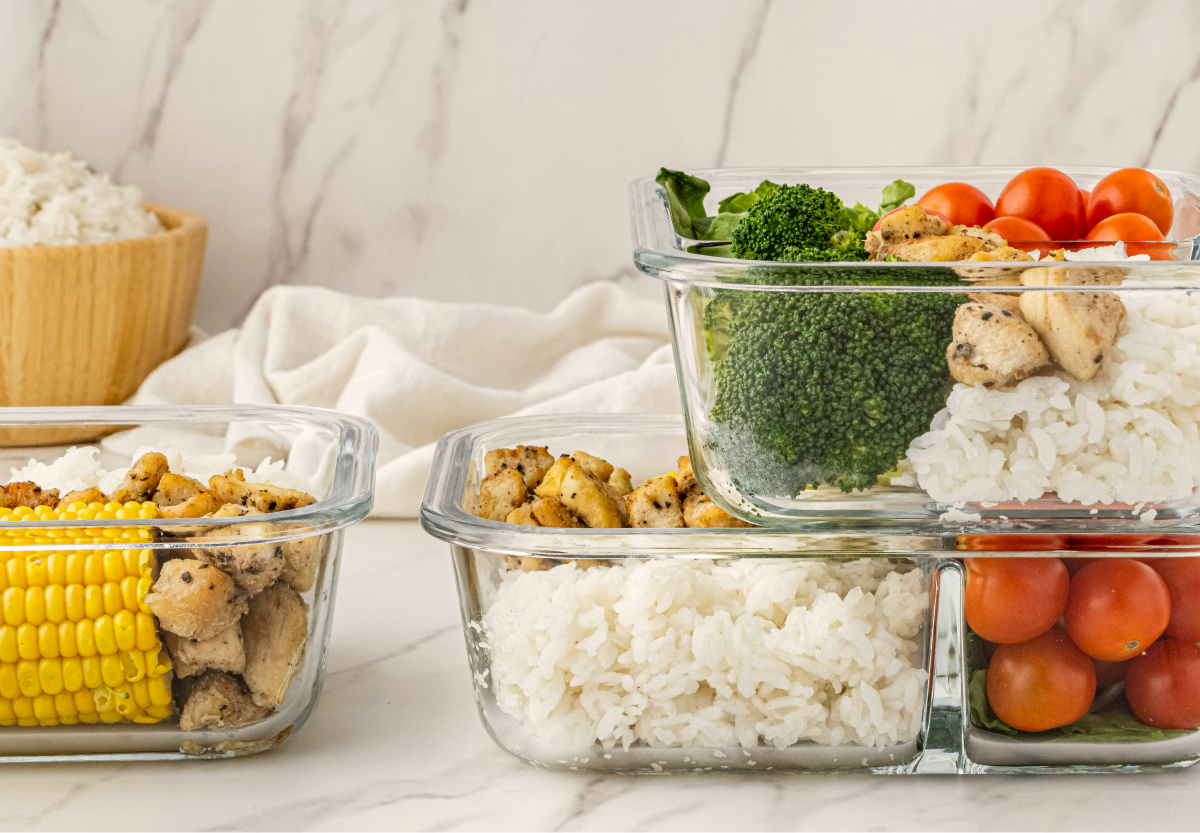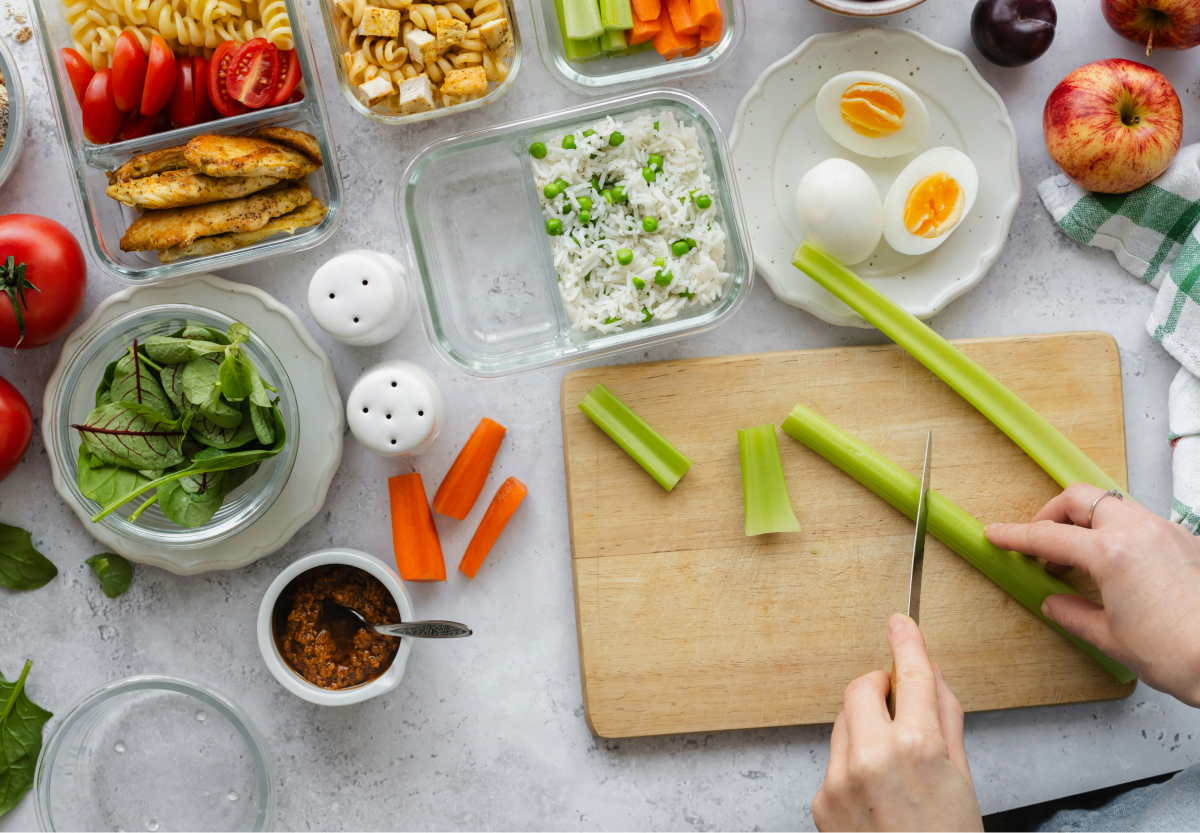How to Eat Healthy on a Budget: Dietitian-Approved Tips
.webp)
Key Takeways
Does eating healthy feel out of reach? Unfortunately, grocery store prices have steadily risen over the past few years. According to the USDA Economic Research Service, the expected increase was 1.2 percent in 2024, while the cost of eating out was projected to rise by nearly 5 percent. But don’t let that derail your healthy eating plans for the new year.
The cost of preparing a homemade meal is often much less than a restaurant meal of comparable quality. It is also associated with better diet quality, making it a healthier, budget-friendly choice. And this doesn’t have to mean hours spent in the kitchen. With smart strategies and guidance from an expert, staying healthy on a budget can be manageable—and even enjoyable. Read on for our dietitian-approved tips and tricks.
Why Eating Healthy Doesn’t Have to Be Expensive

Many people believe that eating healthy requires spending a fortune on organic produce or specialty foods, but this isn’t true. Small, practical changes—like shopping for seasonal produce, prioritizing whole foods, and meal planning—can significantly reduce costs while delivering balanced nutrition.
Misconceptions About Healthy Eating Costs
Many believe healthy eating is always much more challenging to maintain within a tight budget. But there’s a workaround to most that can help you avoid derailing your health goals or sacrificing your financial ones. Here are some common misconceptions we’ll help you get through:
- All healthy food is more expensive: According to a Cleveland Clinic survey, 46 percent of Americans believe healthy food costs more. But you can maintain health goals with kitchen staples like rice, beans, and seasonal produce.
- Healthy eating takes too much time: We’ve got tips below for simple solutions like meal prepping and batch cooking to save time and money!
- Healthy meals are too complicated: That’s where recipe apps and dietitian guidance make a difference—healthy cooking should be accessible to everyone!
- Fast food is more convenient: Its long-term costs—including health-related expenses—can far outweigh any initial convenience.
“Eating healthy doesn’t have to be about perfection or high-end ingredients. With some planning and whole foods, you can nourish your body and stick to your budget,” says glucose expert Amanda Donahue, MS, RD, CD.
Budget-Friendly Healthy Eating Strategies

Eating well on a budget starts with practical strategies focusing on accessible, cost-effective choices.
Shop in Season for Fresh Produce
Seasonal produce is not only more affordable but also fresher and more flavorful. For example:
- Summer: Zucchini, berries, peaches.
- Fall: Sweet potatoes, apples, pumpkins.
Pro tip: “Check local farmers' markets or grocery store specials for low-cost seasonal fruits and vegetables. When fresh produce isn’t available or cost-effective, frozen options are an excellent alternative. Flash-freezing preserves nutrients, making frozen fruits and veggies both economical and nutritious.” — Liz McKinney, MS, CNS, LDN
Buy in Bulk for Cost Savings
Certain staples like whole grains, legumes, nuts, and seeds are cheaper when purchased in bulk. These items have long shelf lives, especially when stored correctly:
- Brown rice, lentils, oats, and canned goods are pantry essentials that can last months.
- You can freeze nuts or seeds to extend their freshness.
Pro Tip: “Use airtight containers for dry goods and label with purchase dates to minimize waste. For example, a 5-pound bag of rice that could cost anywhere between $3 to $6 can be used as the base for dozens of meals. Remember to pick a healthier variety of rice, pair it with protein and nutrient-rich ingredients, and experiment to see how it responds with your body to make your budget-friendly meal a healthy one too.” — Liz McKinney, MS, CNS, LDN
Prioritize Whole Foods Over Processed Foods
Whole foods are not only more nutritious but can also be cost-effective compared to processed or pre-packaged alternatives. Here’s a simple cost comparison of a typical homemade lentil soup versus canned soup as an example, based on some average grocery store prices near us when this was written:
- Dry Lentils: 1.5 cups ($1.50 for a 1-pound bag, using about $0.75 worth).
- Carrots: 3 medium ($1.00 for a bunch, using about $0.50 worth).
- Celery: 3 stalks ($1.50 for a bunch, using about $0.50 worth).
- Onion: 1 medium ($1.00 per onion, using $1.00).
- Garlic: 2 cloves ($0.50 per bulb, using $0.10 worth).
- Vegetable Broth: 4 cups ($2.50 for a carton, using $2.50).
- Olive Oil: 2 tablespoons ($10 for a bottle, using $0.30 worth).
- Spices (cumin, paprika, salt, pepper): Approx. $0.25.
Your total cost could be around $5.90 for six servings or about $0.98 per serving.
Compare this to canned soup, where you can get a can of lentil soup between $2-$3, with about two servings per can.
Pro tip: “Cooking with whole foods also helps you pick the nutrient-dense ingredients your body needs while avoiding hidden sugars and sodium often found in processed meals at the same time. This will help you stay healthier and avoid higher healthcare costs in the long run!” — Molly Downey, RDN, LDN
Meal Planning for Healthy and Affordable Eating

One of the best ways to stick to a budget? Meal planning! It’s a powerful tool to save time and money and make sure you’re prioritizing healthy foods. It also reduces food waste, prevents impulse buys, and can help with blood sugar management.
If you find this overwhelming to even think about, don’t worry—most people do at first. That’s where working with an expert can help. With a few practical tips from a registered dietitian, meal planning can become a simple, stress-free routine.
Here are some other dietitian-recommended, healthy meal prep ideas from the Nutrisense team to get inspired by, and some tips below to get you started:
Plan Your Meals Ahead of Time
A little planning goes a long way. Dedicate just 15–20 minutes each week to plan meals with these dietitian-recommended tips:
- Begin by planning two to three dinners a week instead of every meal. Gradually build from there—and factor in some leftovers for meals in between if possible.
- Focus on recipes that use similar ingredients to save money and reduce waste. For example:some text
- Buy a bunch of spinach to use in smoothies, salads, and omelets.
- Use roasted sweet potatoes in grain bowls and soups as a side dish.
- Allow room for swapping ingredients if something is on sale or unavailable.
Pro Tip: “Use an app like Nutrisense for meal planning. These apps offer recipes and learning resources based on ingredients you already have, making it easier to stay on budget.” — Amanda Donahue, MS, RD, CD
Use a Weekly Grocery List to Avoid Impulse Buys
A detailed grocery list is essential to stay on track and avoid unnecessary purchases. Organize your list by category (e.g., produce, proteins, pantry staples).
Sample grocery list for $50 or less:
- Produce: Carrots, bananas, spinach, onions.
- Proteins: Eggs, canned tuna, lentils.
- Grains: Brown rice, oats, whole-grain bread.
Pro tip:
“I like to use a simple framework to make sure I stay on track:
- Check what you have: Before writing your list, inventory your pantry and freezer to avoid buying duplicates.
- Know your store: If you’re shopping in person, familiarize yourself with the store. For example, the outer aisles of most grocery stores house fresh produce, dairy, and proteins. Spend less time in the center aisles, where processed foods are displayed.
- Shop with intent: Go to the store with your list in hand and avoid shopping when hungry to reduce impulse buys.”
— Amanda Donahue, MS, RD, CD
Batch Cooking and Freezing Meals
For busy schedules, batch cooking is a game-changer and ensures you have healthy options ready to go. It also helps you avoid the temptation of expensive takeout when you’re in a rush!
Dietitian-favorite freezer-friendly meals:
- Vegetable soup: Make a big pot and portion into individual servings.
- Chicken stir-fry: Use a mix of fresh or frozen veggies with rice.
- Lentil stew: Packed with protein and freezes beautifully for future meals.
Pro tip:
“Double recipes for casseroles, soups, or stews and freeze half. You’ll save time later without extra effort. I also like to set aside one day a week (e.g., Sunday) for meal prep. Wash and chop produce, cook grains, and portion meals into containers. Remember, airtight, freezer-safe containers or resealable bags prevent freezer burn and keep meals fresh longer!” — Molly Downey, RDN, LDN
Top Affordable Healthy Foods to Add to Your Diet
Stocking your pantry with versatile, nutrient-dense staples is key to eating healthy on a budget. Here are some must-haves.
Grains, Legumes, and Other Pantry Staples
Staples like brown rice, lentils, quinoa, and canned beans are inexpensive and highly versatile. They form the foundation of countless meals.
Pantry tip: Stock up on staples during sales, and look for coupons or in the discount bin if you’re using ingredients immediately (those closer to the ‘use by’ date can often be cheaper).
Affordable Protein Sources
Protein can be expensive, but affordable options like eggs, canned tuna, tofu, and Greek yogurt are budget-friendly and nutrient-dense.
Serving idea: Scrambled eggs with sautéed vegetables can make a balanced breakfast for less than $1 per serving!
Versatile Vegetables and Fruits for Every Budget
Frozen fruits and vegetables are often cheaper than fresh and are just as nutritious. Flash-frozen produce retains its nutrients and has a much longer shelf life.
Storage tip: Slice fresh produce like bananas or apples and freeze them for later use in smoothies, soups, or baked goods.
Inexpensive Alternatives Our Dietitians Love

Eating healthy doesn’t have to mean splurging on expensive ingredients. Here are smart, specific swaps recommended by Nutrisense dietitians to help you save money while keeping meals delicious and nutrient-packed. Remember to read the nutritional labels for all these swaps below so you’re not sacrificing healthy food for your budget-friendly meal.
- Choose generic over name brand: Store-brand products are often identical in quality to name-brand items.
- Swap fresh for canned fish. Canned fish often offers the same omega-3 benefits at a fraction of the cost.
- Replace almond butter with peanut butter: They’re not the same, but when you’re on a very tight budget, peanut butter may offer similar protein and healthy fats at a far more affordable rate.
- Opt for skinless chicken thighs instead of breasts: Thighs are often cheaper (and more flavorful!). For leaner meat, consider cuts of turkey that may be on sale around the holidays.
- Use regular whole grains over specialty items: Replace quinoa with brown rice or barley for a similar texture and nutrient profile, for example. And here’s a pro tip from our nutrition experts: "Whole wheat bread" is just as good, sometimes better, than the "5 grain/seed" bread you see advertised. It can often have higher protein and fiber content, too!
- Choose whole lettuce: Whole heads are fresher, last longer, and cost less than the bagged mixes at the store.
- Replace Greek yogurt with cottage cheese: Cottage cheese offers comparable protein, typically at a cheaper price.
- Substitute steaks with ground or chuck: Ground beef and chuck roast are affordable and versatile options for high-protein meals. Use a cooking method like instant or crockpot for tougher cuts, or enjoy a slow-cooked stew so they’re still delicious. Save the steaks for a celebration!
Quick and Easy Budget-Friendly Meal Ideas
Now that your pantry is stocked with staples, how do you turn them into quick, healthy meals without spending hours in the kitchen? These dietitian-approved nutritious meal options are affordable and easy to make. Think of this section as your go-to guide for budget-friendly, healthy recipe inspiration!
Breakfast
- Oatmeal with Toppings from Cookie & Kate
- Berry Spinach Smoothie from the Minimalist Baker
- Peanut Butter Whole-Grain Toast from Bon Appétit
Lunch
- Lentil Soup with Whole-Grain Bread from Cookie & Kate
- Veggie Rice Bowls from the Minimalist Baker
- Hummus Veggie Wrap from Love and Lemons
Dinner Ideas
- One-Pot Pasta with Veggies from Damn Delicious
- Chicken Stir-Fry with Rice from AllRecipes
- Sweet Potato Lentil Curry from Feasting at Home
Consider homemade trail mix or some crispy roasted chickpeas if you need snack ideas. Or read our dietitian recommendations here for more healthy snack options!
Additional Tips to Stretch Your Grocery Budget

Shop store brands and discount stores
Generic brands often provide the same quality as name brands but at a lower price. Discount chains like Aldi or Costco can save you even more. Also, check your local grocery store’s loyalty program for recurring savings.
Reduce food waste with smart storage
Food waste can be costly! Use airtight containers for dry goods (our experts recommend boxes like Rubbermaid for produce like spinach, too!) and freeze perishable items like herbs in olive oil cubes. Also, follow the “first in, first out” principle when picking foods to eat. This ensures older items are used before newer ones, so you’re not wasting your food or money!
Grow food indoors
Even without a garden, you can grow fresh produce indoors on a balcony or even in your kitchen with a hydroponic garden. If you don’t have the budget for a hydroponic setup, start by regrowing from scraps, like green onion bulbs, celery bases, or lettuce ends in water. You can also grow cherry tomatoes, peppers, or herbs in pots on windowsills or patios.
Join a community garden
You can plant food or volunteer in exchange for fresh produce at a community garden. You can also join co-ops for cheaper organic, locally grown foods. Or, try getting an affordable CSA (community-supported agriculture) box in your area.
Use a food-sharing or rescue app
From surplus food from restaurants to grocery store spillover, you’d be surprised at some of the great food you can get from food rescue apps that would otherwise go to waste—usually at heavily discounted prices. Try apps like Too Good To Go or grocery services like Misfits Markets or Imperfect Foods.
Find the right Nutrisense programto turn insight into progress.
Eat Healthy on a Budget with Nutrisense
When you work with an expert, you’ll find that eating healthy doesn’t have to break the bank. For additional support, consider working 1:1 with a registered dietitian to create a sustainable meal plan tailored to your goals and preferences. A professional can provide insight into meal prep, portioning, and more!
Using a tool like a continuous glucose monitor can also help you see your body’s response to foods. With personalized insights and expert advice at Nutrisense, you can incorporate budget-friendly meals into your routine while maintaining a balanced diet tailored to your unique needs. Ready to take the guesswork out of your diet and lifestyle habits? Sign up for Nutrisense today to unlock the potential of personalized health!
Go Beyond Glucose Data with Nutrisense
Your glucose can significantly impact how your body feels and functions. That’s why stable levels are an important factor in supporting overall wellbeing. But viewing glucose isn't enough. Nutrisense, you’ll be able to learn how to use your body's data to make informed lifestyle choices that support healthy living.
One-to-one coaching
Sign up to access insurance-covered video calls to work with a glucose expert: a personal registered dietitian or certified nutritionist who will help tailor your lifestyle and diet to your goals.
Monitor and measure what matters
With the Nutrisense CGM Program, you can monitor your glucose with health tech like glucose biosensors and continuous glucose monitor (CGM)s, and analyze the trends over time with the Nutrisense App. This will help you make the most informed choices about the foods you consume and their impact on your health.
Find your best fit
Ready to take the first step? Start with our quiz to find the right Nutrisense program to help you take control.

Amanda is a Nutrition Manager and Registered Dietitian, with a Masters in Dietetics from Stephen F. Austin State University. Originally from south GA, she got her undergrad degree from Texas Tech University. She worked at a hospital in Fort Worth, TX, for 4 years as a dietitian, counseling those living with HIV.




